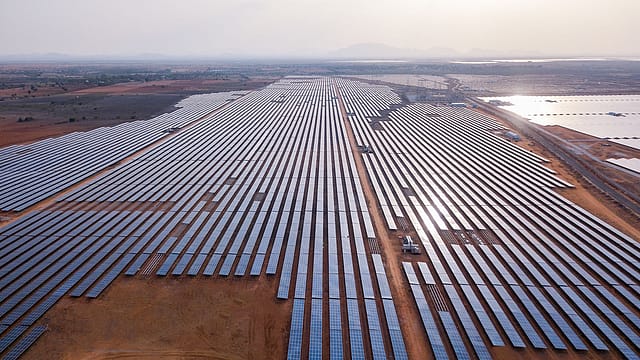Amid tariff war with China, Indian solar equipment makers hope to partner with the U.S.
ADVERTISEMENT

In his latest volte-face, US President Donald Trump has announced exempting solar cells (in addition to smartphones, computers, semiconductors and certain electronics parts) from the 125% reciprocal tariffs on China. However, the decision is unlikely to have a severe impact on Indian solar module exporters to the US, at least for the next few years, say industry experts. They cite that the US, which currently lacks a large solar equipment manufacturing ecosystem, will have to be dependent on solar cells and module imports for at least 2-3 years, from countries like India and other Asian countries.
US's Solar Dilemma
In 2024, the US solar industry installed nearly 50 gigawatts (GW) of capacity, a 21% increase from 2023 and the highest ever in the last two decades. Now its solar capacity stands at 237.5 GW, according to the Solar Energy Industries Association (SEIA), USA. The value of the US solar market in 2024 was $70.4 billion and is projected to grow to 739 GW by 2035, with average annual capacity additions of more than 45 GW, says SEIA.
Solar accounted for 66% of all new electricity-generating capacity added to the US grid in 2024. But its domestic module manufacturing capacity, which grew an unprecedented 190% year-over-year from just 14.5 GW at the end of 2023, stood at 42.1 GW at the end of 2024 and surpassed 50 GW in early 2025. The US imported over 75% of the $16.5 billion worth of solar modules and cells in 2024. Of this, more than half directly or indirectly came from China, say sources.
December 2025
The annual Fortune 500 India list, the definitive compendium of corporate performance, is out. This year, the cumulative revenue of the Fortune 500 India companies has breached $2 trillion for the first time. Plus, find out which are the Best B-schools in India.
In the case of cells and raw materials, the US is import-dependent, either directly or indirectly, from China.
Suniva, America’s oldest and largest monocrystalline solar cell manufacturer, founded in 2007, had production facilities in Georgia and Michigan. The company went bankrupt in 2017 and closed down, citing its inability to compete with cheap solar imports, mainly from China. Following the Inflation Reduction Act (IRA) of 2022 in the US, which promotes domestic clean energy manufacturing, Suniva decided to restart and upgrade its factory in Norcross, Georgia. Aiding companies like Suniva, the George Biden administration doubled tariffs on solar cells, modules and the main raw material, polysilicon imported from China, to 50%.
In 2023, Suniva decided to revive its plant in Georgia, which earlier operated at around 450 MW, with an initial capacity of 1 GW. In March, Suniva, solar PV module manufacturer Heliene and wafer maker Corning announced plans to manufacture the first US-made modules made with polysilicon, wafers and cells manufactured in the United States.
The US has been waging a trade war with China on solar imports for over a decade, but China circumvented the US by moving production to other Southeast Asian countries like Vietnam and exporting to the US. Manufacturing costs in the US are prohibitive when compared to China's huge capacity and cheap production costs.
India Advantage
In the last decade, India has transformed from a net importer to a net exporter of solar modules. In FY24, Indian solar manufacturers exported approximately $2 billion worth of PV modules. "The export value of PV modules from India increased by more than 23 times in just two years between FY22 and FY24 and most Indian module exports are to the US, which accounted for 97% and 99% of India’s PV exports in FY2023 and FY2024, respectively," says researchers with JMK Research. India also exports PV modules to South Africa, Somalia, Kenya, the UAE, Afghanistan, Nepal and Bangladesh.
A decade ago, India was dependent on China for over 80% of the cells and modules. Once India set a target of 500 GW of renewable energy, with 290 GW to come from solar energy, numerous domestic manufacturers increased their capacities. New large capacities are coming up. Mukesh Ambani-led Reliance Industries is setting up a 10 GW solar cell and module factory in Jamnagar and is close to starting production. Planned as a fully integrated Gigafactory from starting raw materials to final cell and module, Plans are to scale up annual capacity to 20 GW by 2026. TP Solar, a subsidiary of Tata Power Renewable Energy, recently launched its 4.3 gigawatt (GW) solar cell and module manufacturing facility at Tirunelveli in Tamil Nadu. Recently, Waaree Energies launched a 5.4 GW solar cell Gigafactory facility in Chikhli, Gujarat, the largest so far in India.
India's solar module manufacturing capacity will double from 80 GW to 160 GW and that of cell manufacturing capacity from 15 GW to 120 GW by 2030. Wafer and polysilicon capacities are also expected to reach 100 GW each by 2030, Subramanyam Pulipaka, CEO of the National Solar Energy Federation of India (NSEFI), said last week at an industry event.
Until FY24, three of the largest domestic PV manufacturers – Waaree Energies, Adani Solar and Vikram Solar were exporting over half of their production. Of late, several other Indian new manufacturers like Grew Energy, ReNew Power, Navitas, Solex Energy and Saatvik Energy, are pursuing export markets and setting up supply chains abroad, noted the JMK Research report. Companies like Waaree Energies and Vikram Solar had announced their plans to set up units in the US.
With the US trying to develop a solar equipment manufacturing ecosystem sans China, Indian companies are likely to be the major partner, hope Indian manufacturers.
